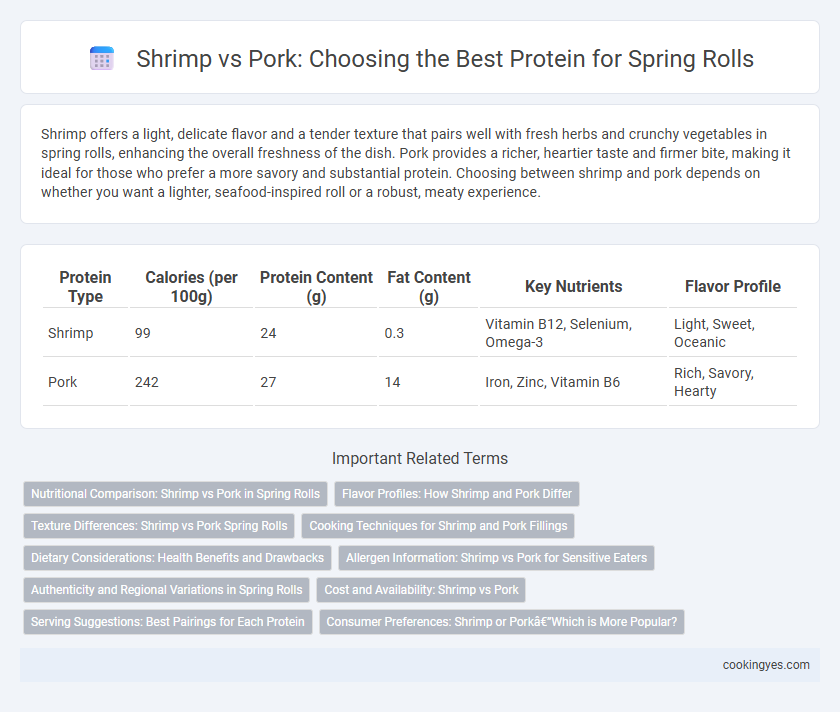Shrimp offers a light, delicate flavor and a tender texture that pairs well with fresh herbs and crunchy vegetables in spring rolls, enhancing the overall freshness of the dish. Pork provides a richer, heartier taste and firmer bite, making it ideal for those who prefer a more savory and substantial protein. Choosing between shrimp and pork depends on whether you want a lighter, seafood-inspired roll or a robust, meaty experience.
Table of Comparison
| Protein Type | Calories (per 100g) | Protein Content (g) | Fat Content (g) | Key Nutrients | Flavor Profile |
|---|---|---|---|---|---|
| Shrimp | 99 | 24 | 0.3 | Vitamin B12, Selenium, Omega-3 | Light, Sweet, Oceanic |
| Pork | 242 | 27 | 14 | Iron, Zinc, Vitamin B6 | Rich, Savory, Hearty |
Nutritional Comparison: Shrimp vs Pork in Spring Rolls
Shrimp provides a lean source of protein with lower calories and fat compared to pork, making it a heart-healthy option for spring rolls. Pork offers higher fat content and essential nutrients like iron and zinc, contributing to a richer flavor and greater satiety. Choosing shrimp supports lower cholesterol intake, while pork supplies a more abundant source of B vitamins important for energy metabolism.
Flavor Profiles: How Shrimp and Pork Differ
Shrimp offers a light, sweet, and slightly briny flavor that enhances the fresh and crisp texture of spring rolls, providing a delicate seafood essence. Pork delivers a rich, savory, and umami-packed taste with a tender, juicy texture that adds depth and heartiness to the filling. Combining shrimp and pork balances sweetness and savoriness, creating a complex and satisfying flavor profile in spring rolls.
Texture Differences: Shrimp vs Pork Spring Rolls
Shrimp spring rolls offer a firm, slightly chewy texture that contrasts with the tender, juicy feel of pork spring rolls, creating a lighter mouthfeel ideal for fresh rolls. Pork provides a richer, denser bite with a succulent, fatty quality that enhances the savory depth in fried spring rolls. Choosing shrimp emphasizes a clean, crisp texture, while pork delivers a hearty, satisfying chew, catering to diverse sensory preferences in spring roll variations.
Cooking Techniques for Shrimp and Pork Fillings
Shrimp for spring rolls requires quick cooking methods like sauteing or steaming to preserve its delicate texture and natural sweetness, often seasoned lightly with garlic and ginger to enhance flavor without overpowering. Pork fillings benefit from slow cooking techniques such as braising or stir-frying ground pork with soy sauce, five-spice powder, and finely chopped vegetables to develop a rich, savory taste and tender consistency. Balancing moisture content and proper cooking times ensures both shrimp and pork fillings maintain their juicy texture and integrate seamlessly into crisp spring roll wrappers.
Dietary Considerations: Health Benefits and Drawbacks
Shrimp offers a low-calorie, high-protein option rich in omega-3 fatty acids, which support heart health and reduce inflammation, making it ideal for weight-conscious individuals and those seeking lean protein sources. Pork provides a higher fat content and more saturated fats, contributing to increased calorie intake and potential cardiovascular concerns if consumed excessively. Choosing shrimp over pork in spring rolls benefits those managing cholesterol levels or following low-fat diets, while pork can supply essential B vitamins and iron but may require moderation.
Allergen Information: Shrimp vs Pork for Sensitive Eaters
Shrimp, a common allergen, poses significant risks for sensitive eaters due to its high allergenic proteins like tropomyosin, often triggering severe allergic reactions. Pork, on the other hand, is less likely to cause allergic responses, making it a safer protein choice for those with food sensitivities or shellfish allergies in spring rolls. Careful ingredient labeling is essential to protect individuals with shrimp allergies while catering to diverse dietary needs.
Authenticity and Regional Variations in Spring Rolls
Shrimp offers a coastal authenticity to spring rolls, especially in Vietnamese and Thai cuisines where fresh seafood is abundant, creating a light and savory flavor profile. Pork, commonly used in Chinese and Filipino spring rolls, provides a rich and hearty taste that reflects their regional preference for robust, meaty fillings. These protein choices highlight the distinct culinary traditions and local ingredient availability that shape spring roll variations across Asia.
Cost and Availability: Shrimp vs Pork
Pork is generally more cost-effective and widely available year-round compared to shrimp, making it a budget-friendly protein choice for spring rolls. Shrimp prices tend to fluctuate due to seasonality and supply chain variables, often making it a more premium option. Pork's consistent availability in local markets ensures easier sourcing, while shrimp may require specialized suppliers or frozen alternatives in some regions.
Serving Suggestions: Best Pairings for Each Protein
Shrimp spring rolls pair exceptionally well with light, citrusy dipping sauces like sweet chili or lime garlic, enhancing their natural sweetness and tender texture. Pork spring rolls benefit from rich, savory accompaniments such as hoisin sauce or peanut sauce, which complement the meat's robust flavor and provide a satisfying umami balance. Fresh herbs like mint and cilantro and crisp vegetables like cucumber and shredded carrots elevate both proteins, offering refreshing contrasts that enhance the overall taste experience.
Consumer Preferences: Shrimp or Pork—Which is More Popular?
Consumer preferences for spring roll protein typically favor shrimp due to its light, sweet flavor and perceived health benefits, appealing to those seeking a seafood option. Pork remains popular among traditionalists who appreciate its rich, savory taste and tender texture, often associated with authentic recipes. Market surveys indicate shrimp-based spring rolls experience higher popularity in coastal regions, while pork versions dominate in more inland areas.
Shrimp vs pork for spring roll protein Infographic

 cookingyes.com
cookingyes.com